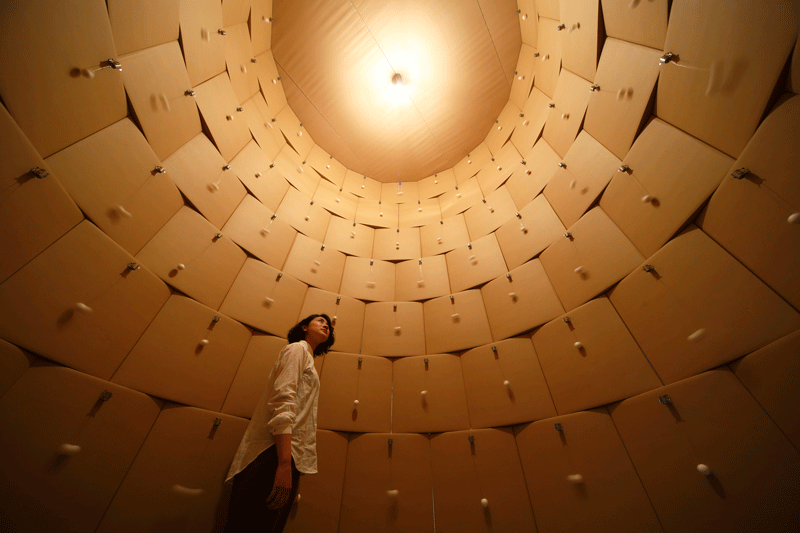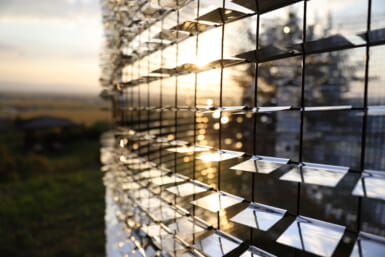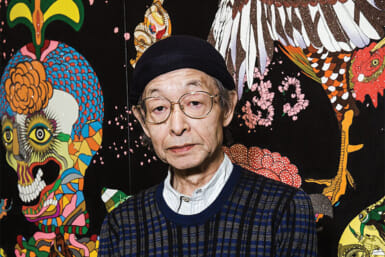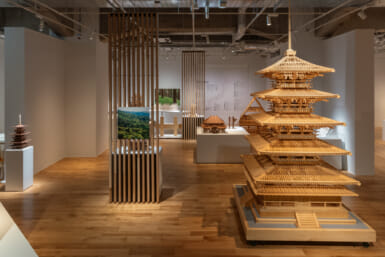This month we bring you three very different exhibitions, housed in equally varied spaces—a major museum, a Tadao Ando–designed modern gallery, and a small showroom. One makes use of gunpowder, another mechanics and the third memorabilia, yet all rely on collaboration, supporting artists’ visions with a community of creative friends and colleagues.
By Sarah Custen
“Cai Guo-Qiang: There and Back Again”
Flowery phrases and carefully-chosen words cannot do justice to this exhibition, which is, basically, so freaking cool. Life-like wolves fly through the air by the dozens, gunpowder dusts and shades ceramics, and colors and lines explode across massive canvases, bursting into life in the shapes of flowers, lovers, animals, art.
Cai Guo-Qiang is a world-renowned artist, most recognized for his use of pyrotechnics in his large-scale creations, some of which border on performance art. Born in China, practiced in Japan and now living in New York City, Cai works most often with gunpowder, one of China’s “Four Great Inventions.” Used for decades in weaponry and warfare, this explosive is transformed through Cai’s brilliant vision from destructor to creator, rendering canvases and sculptures that are more reminiscent of fireworks than firearms.
“Although Cai seems to use the form of Western art presentations, such as installation or performance art, his presentation is a sort of ritual in the context of ancient Chinese art, “Yishu,” explained Naoaki Nakamura, Senior Curator for the Yokohama Museum of Art. “By transforming the symbolic motive of the place where his work is manufactured and presented, Cai gives new meaning to the motive and exhibits it in a metaphorical manner.”
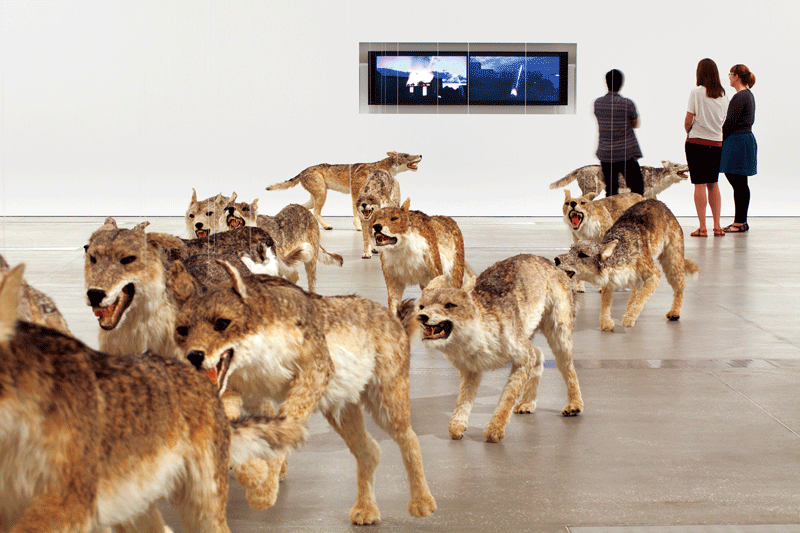
The Deutsche Bank Collection, Photo by KAMIYAMA Yosuke, Installation view of Head On, Yokohama Museum of Art, 2015. 99 life-sized replicas of wolves and glass wall. Wolves: gauze, resin, and hide Dimensions variable
Cai’s “Seasons of Life” is breathtaking, a vibrant expression of life and death that is lush, violent, bloody, gorgeous and carnal. This theme is echoed in his “Nighttime Sakura,” an enormous composite canvas that greets visitors upon entry. “He loves Sakura because it resembles fireworks or gunpowder in the short bloom and the dual connotation of life and death,” explained Nakamura.
His ceramic-based “Spring, Summer, Winter, Fall” is like an image from a dream, at once real, surreal, hyper-real and unreal: impossibly delicate and smooth porcelain, thin like paper, with complex shadows rendered by flame and smoke, like an heirloom rescued from a burnt-down house, or fine china salvaged from the Titanic, murky yet bright as it swims up to us from the depths. And then of course, the true showstopper: Cai’s “Head On,” a room filled with taxidermy-style wolf replicas, snarling, prowling, leaping and taking flight towards a head-on collision with a massive glass wall. It is frightening, compelling, provocative, and beautiful.
Several of the exhibitions works are made possible through collaborations with local artists, students and volunteers. “The collaboration of residents is an important part of Cai’s art, because he wants to know and learn from the people whom he will show his works,” said Nakamura, explaining that “Nighttime Sakura” utilized some 40 volunteers. For “Morning Glory,” he explained, the museum worked with students from Yokohama College of Art and Design, which has a special ceramics course, as well as the Tokyo University of Arts, to make a short documentary video, which proved to be one of the most enthralling aspects of the exhibition, allowing visitors an intimate look at Cai’s creative process.
“Not only the artworks individually, but also the whole installation of the exhibition reflects Cai’s idea,” said Nakamura. “Through transforming symbolic motives from Japanese art and culture, Cai sends us a new message.” He suggests that you see the exhibition, to find your answer.
Yokohama Museum of Art
July 11–October 18, 2015
Open daily 10:00–18:00; closed Thursdays
yokohama.art.museum/special/2015/caiguoqiang/english.html
“Motion Science”
Seiichi Hishikawa is best known for corporate advertisements and the opening sequences of NHK’s historical drama series, a man whose work represents big ideas and even bigger audiences. Yet he started the “Motion Science” experience with a blank slate.
“When Mr. Hishikawa was offered [the position] as exhibition director, the content was not yet determined,” said 21_21 DESIGN SIGHT PR representative Shotaro Okada. “He built the content while researching with others.”
Indeed, the exhibitions moving and interactive works were born of Hishikawa’s collaboration with companies, creators and students, focussing on exploring and explaining gravity, wavelength and inertia, phenomena which “are not yet completely understood, even in the digital society,” according to Hishikawa’s official Director’s Statement. He goes on, “We hope that, in this modern age overflowing with information, the exhibition will become an opportunity to rethink…from a perspective of ‘motion.’”
The exhibition follows an open flow, including many behind-the-scenes looks at the mechanisms of how works are made. Children and adults alike are invited to touch, listen, walk through, witness and otherwise explore the space around them. “Visitors can play while learning the structure of the works,” said Okada, explaining that Hishikawa doesn’t view making things as a “black box.” This is David Macaulay’s “The Way Things Work” come to life.
Visitors are also able to experience the mechanism of motion through animation produced by DRAWING AND MANUAL, under Hishikawa’s supervision, which shows movement’s underlying fundamentals.
“Today, a variety of information and knowledge is available in an instant via the Internet. But how we manipulate it to make something new is more important than just the information itself,” said Hishikawa. “The impulse of ‘wanting to try to make something,’ not knowing if it will be useful, is more important than difficult theories or job titles…we need to stir the heart.”
21_21 DESIGN SIGHT
June 19–September 27, 2015
Open daily 10:00–19:00; closed Tuesdays
www.2121designsight.jp/en/program/motion_science/
“Erik Satie and His Time”
Similar in tone and intention to the Jules Pascin exhibition from this past March, “Erik Satie and His Time” is a lighthearted yet fascinating presentation, approaching Satie tangentially by exploring the rich collection of artistic and cultural relationships that influenced his musical life and compositions. Nestled inside the delightfully faux-French Bunkamura building in Shibuya, the Museum offers a pleasant respite from summer’s thick heat. Slow, sleepy, sweet music follows you as you glide from room to room, tracing Satie’s career from his early days in Montemartre through his achievement and acclaim as an innovative composer.
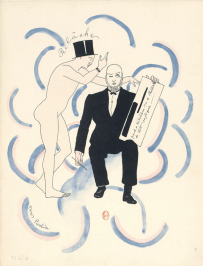
Francis Picabia 《Le frontispice du partition de「Relâche」》1926
Paris: Rouart, Lerolle et Cie / Lithographie sur papier
Bibliothèque nationale de France, Paris
Soft melodies float and fade, replaced by others, gently beckoning you onward, from big, bold cabaret posters (the unmistakable work of Jules Chéret and Henri de Toulouse-Lautrec), through well-preserved scores and manuscripts in Satie’s neatly ornate art nouveau hand, to photos and videos capturing his modernist years, all the while subtly name dropping the artists and movements to which Satie was closely linked.
Familiar faces and names line the walls, offering a kaleidoscopic vision of Satie, rendered in myriad portraits by artists and friends like Constantin Brancusi and Man Ray. Picasso is there, with a micro gallery of sketches, gouache and watercolors, followed by Jean Cocteau, Georges Braque and André Derain. Yet the associations never feel showy, but rather intimate, a closeness which is reinforced through the display of affects from Satie’s daily life, including his ubiquitous bowler hat.
“I really liked how all the artifacts, like Satie’s hat and cane, posters from Montmartre, his handwriting and notation—all things that you would think couldn’t affect how you heard his music–actually added something to it,” said Dr. Adam Loughnane, a Canadian professor of Philosophy who recently visited the exhibition. “Maybe that changed the way [Satie’s music] sounds, made it more real or palpable.”
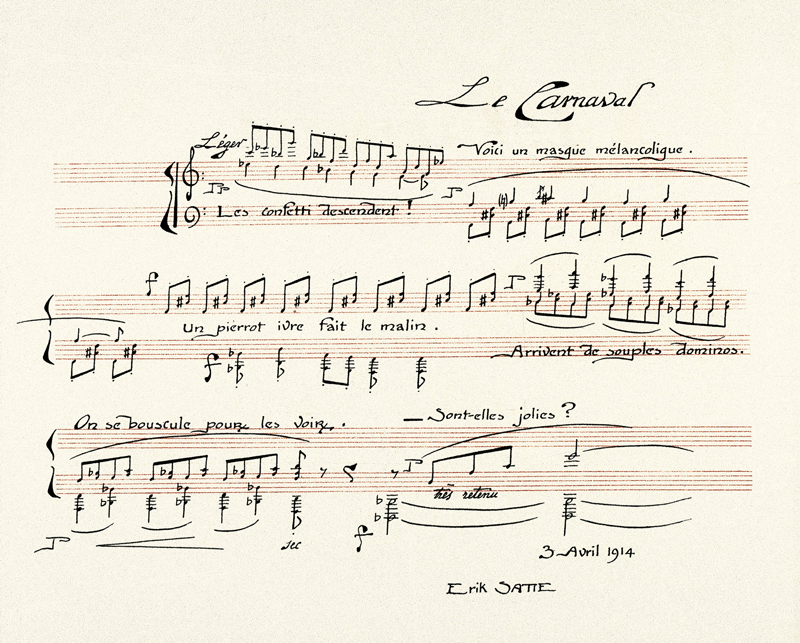
Erik Satie (composition), Charles Martin (illustration)
Sports et Divertissements
1914-1923, pochoir sur papier, Fonds Erik Satie – Archives de France / Archives IMEC
The Museum at Bunkamura
July 8–August 30, 2015
Open Sunday through Thursday, 10:00–19:00; Fridays and Saturdays until 21:00
http://www.bunkamura.co.jp/english/museum/20150708.html
Main Image: The Deutsche Bank Collection, Photo by KAMIYAMA Yosuke , Installation view of Head On, Yokohama Museum of Art, 2015. 99 life-sized replicas of wolves and glass wall. Wolves: gauze, resin, and hide Dimensions variable


